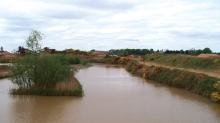Mitsubishi Cement is months away from learning if it can proceed on its planned expansion of its quarry six miles southeast of Lucerne Valley town in southern Mojave Desert, California.
Mitsubishi and its consultants are working on the Final Environmental Impact Report of its South Quarry project. Following its anticipated release in June, the San Bernardino County Board of Supervisors and US, reports the reports the Daily Press.
Forest Service then will consider approving the EIR, which has been in the works since 2009. If the county and Forest Service give the green light, Mitsubishi will submit the final document, probably before year’s end.
“The South Quarry application requests expansion of the limestone quarry resources for 120 years,” said David Rib, Mitsubishi Cement's environmental manager.
“Without that expansion (Mitsubishi’s) Cushenbury Plant would need to bring in limestone from other sources, with a drastic increase in truck deliveries to an already busy roadway,” he said.
Furthermore, mining and cement manufacture are significant industries for Lucerne Valley and the Victor Valley area, providing hundreds of well-paid jobs directly and many hundreds more indirectly.
According to Rib, the Mitsubishi Cement Corporation has about 150 employees at the Cushenbury Cement Plant and brings in more than 100 contractor employees during annual major maintenance projects.
The plant spends more than $12 million annually with local vendors and supports numerous community organizations. Besides employing numerous local workers since taking over the mine, Mitsubishi also donates thousands of dollars annually to local schools through its Mitsubishi Cement Corporation Educational Foundation. ???? Several local organizations and local leaders have lent their support to the South Quarry project.
Bell warns that not approving the project could have dire consequences for the region, especially Lucerne Valley. “If Mitsubishi does not receive approval for the project for that duration, it may have to ship limestone in from other sources to its cement plant,” he wrote.
“That would lead to undesirable impacts from the large trucks that would pass through Lucerne Valley to deliver limestone to Mitsubishi’s cement plant. This project does not increase the amount of cement produced or truck traffic through our community on a daily basis, only extending the long-term availability of its limestone resource, which is critical for Mitsubishi Cement and Lucerne Valley.”
Rep. Paul Cook, R-Apple Valley, also sent a letter of support, citing Mitsubishi’s mitigating measures for any environmental issues and that the cement plant “is a major job creator in my district.”
Throughout the EIR process, Mitsubishi has sought to demonstrate how it will mitigate environmental related issues and concerns. “The Environmental Report includes long lists of permit conditions to ensure the process is sustainable and minimizes any impacts,” Rib said.
“With the long term of the requested project, many of these conditions are on-going programs under agency supervision so the activities may evolve with changing needs and developing science.” ?
Meanwhile, some environmentalists have expressed concern that the South Quarry project will encroach on the nearby national forest and that a 120-year operating permit is too long. They also are concerned with a group of bighorn sheep that migrate through the area and that the project may destroy rare native plants.
The South Quarry will be located on 128 acres, mostly on public land in Cushenbury Canyon. It will be located near Mitsubishi Cement’s west pit. Henry J. Kaiser started mining product from the Cushenbury limestone quarry during World War II for use at his Fontana steel mill. He built a cement plant in 1957. After plant modernization in 1982, Mitsubishi Cement purchased the plant in 1988.






